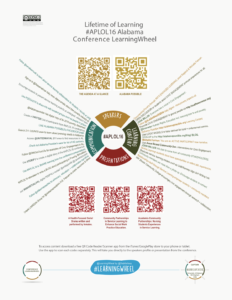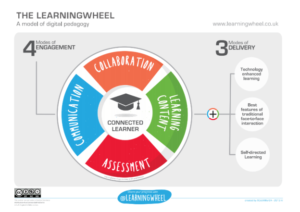Using Learning Wheels: The #APLOL16 Connected Conference
In this short blog, we (Amanda Taylor and Laurel Hitchcock) outline the success of the #APLOL16 Conference LearningWheel and through doing so hope to encourage social work and indeed other professions to consider this methodology as a conduit for collating and disseminating conference content.
Why a Conference Learning Wheel?
 I reached out to Amanda earlier this year about setting up a Conference LearningWheel for Alabama Possible’s 2016 Lifetime of Learning Conference because I had previously participated in the development of LearningWheels for other conferences, and saw several benefits for #APLOL16. First, a Conference LearningWheel helps document learning that occurs during and after a conference. By contributing short sentences (which become spokes of the wheel), conference attendees can share their insights, feedback and comments about the different conference sessions with an audience beyond that session and even beyond the conference. Second, the LearningWheel also captures how conference attendees can best communicate with each other during or after a conference, and with others such as colleagues, students, community partners, or any like-minded person. This is ideal for encouraging conference attendees to apply what they learned in their professional settings and promote collaborations. Finally, I hope Alabama Possible can use the Conference LearningWheel as an evaluation tool to help assess the outcomes from #APLOL16 and to plan next year’s conference.
I reached out to Amanda earlier this year about setting up a Conference LearningWheel for Alabama Possible’s 2016 Lifetime of Learning Conference because I had previously participated in the development of LearningWheels for other conferences, and saw several benefits for #APLOL16. First, a Conference LearningWheel helps document learning that occurs during and after a conference. By contributing short sentences (which become spokes of the wheel), conference attendees can share their insights, feedback and comments about the different conference sessions with an audience beyond that session and even beyond the conference. Second, the LearningWheel also captures how conference attendees can best communicate with each other during or after a conference, and with others such as colleagues, students, community partners, or any like-minded person. This is ideal for encouraging conference attendees to apply what they learned in their professional settings and promote collaborations. Finally, I hope Alabama Possible can use the Conference LearningWheel as an evaluation tool to help assess the outcomes from #APLOL16 and to plan next year’s conference.
Conferences host and generate a wealth of knowledge and in doing so create a plethora of thinking that is often restricted when exposure is limited to the delegates in attendance. It is assumed that knowledge acquired will be shared in some way or another within the professional community – and to it degree it is. However, given that the world is becoming a much smaller place and communities are becoming much more connected it makes sense to at least consider what could happen when the ‘whole’ of a profession are offered the opportunity to engage in the debate. And yes we accept that not everyone is as yet operant within the digital sphere but again this is where engaging with the method can assist with the development of professional knowledge gaps.
What is a Conference LearningWheel?
The idea for Conference LearningWheels builds upon the original LearningWheel innovation which was in essence developed to support engagement with digital resources and blending learning  methods within the educational context (Kellsey & Taylor, 2016). The Conference LearningWheel was primarily designed (by @amltaylor66) as a means through which to collate conference content and disseminate this in a way that would offer a professional community access to the presentations and papers shared within a physical conference space. Embedded into the process is the opportunity for the wider professional community to engage in the sharing of research, practice and to network more than would normally be possible. A process that aims to keep the ‘conversations’ in relation to the conference themes open, going and participatory.
methods within the educational context (Kellsey & Taylor, 2016). The Conference LearningWheel was primarily designed (by @amltaylor66) as a means through which to collate conference content and disseminate this in a way that would offer a professional community access to the presentations and papers shared within a physical conference space. Embedded into the process is the opportunity for the wider professional community to engage in the sharing of research, practice and to network more than would normally be possible. A process that aims to keep the ‘conversations’ in relation to the conference themes open, going and participatory.
The process of collating content is made possible through the use of the online platform GoogleDocs, created as a space in which presenters and delegates are encouraged to offer learning content drawn from the conference presentations and papers. It is this content that will ultimately form spokes of the LearningWheel that in total will make up the final visual resource.
How we implemented the #APLOL16 Conference LearningWheel?
Once the collection tool (GoogleDoc) was set-up, we used the following tactics to encourage participation with the LearningWheel during the conference:
- Communicated with all conference presenters in advance to get their buy-in with the Conference LearningWheel. We shared details that described the LearningWheel, how they could contribute to it, and how they could include their digital presentations.
- Recruited volunteers to help populate the LearningWheel. For each session, we identified attendees who would attend different sessions with the purpose of writing spokes based on what they heard at the sessions. We provided one-page handout on how to add content and provided examples.
- Promoted the Conference LearningWheel via Twitter. Through the morning of the conference, we heavily tweeted about the LearningWheel, and asked participants to add their content.
Next steps for the #APLOL16 Conference LearningWheel is to distribute it – widely and frequently. It will be posted with the Conference LearningWheel Collection and on the Alabama Possible website and social media platforms. Finally, as previously noted, we plan to incorporate our Conference LearningWheel into the evaluation process and planning for next year’s conference. Stay tuned for a follow-up blog post about how this process worked for us.
If you are interested in creating a LearningWheel for your next conference or event, please contact @learningwheel via Twitter.
#APLOL16 Conference LearningWheel was curated and collated by @laurelhitchcock and evidences how this innovation developed by @amltaylor66 can connect the social work profession with new and emerging knowledge in an inclusive manner.
References:
Kellsey, D. and Taylor, A.M.L. (2016). The LearningWheel: A Model of Digital Pedagogy. Northwich: Critical Publishing. Available from: https://www.amazon.co.uk/Learningwheel-Model-Digital-Pedagogy/dp/1911106384/ref=sr_1_1?s=books&ie=UTF8&qid=1477660442&sr=1-1&keywords=the+learningwheel
How to cite this post:
Hitchcock, L., Taylor, A. (2016, November 18). Using Learning Wheels: The #APLOL16 Connected Conference [Blog Post]. Retrieved from https://laureliversonhitchcock.org/2016/11/18/using-learning-wheels-the-aplol16-connected-conference/.


